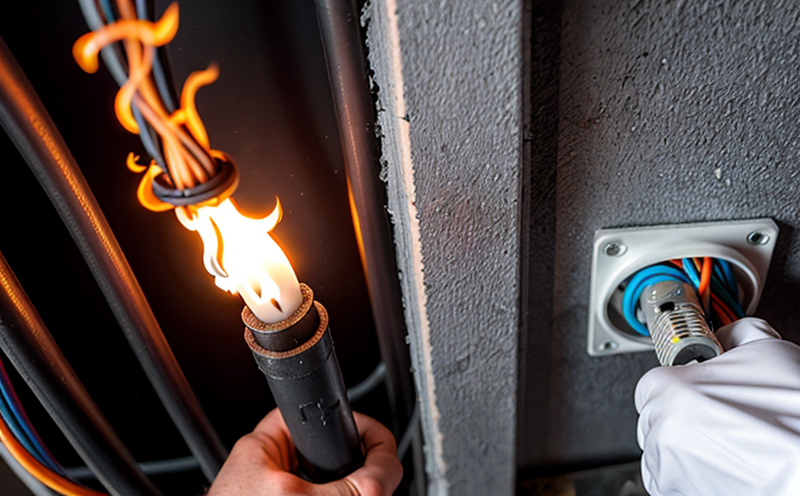IEC 61034-1 Measurement of Smoke Density in Cables
The International Electrotechnical Commission (IEC) standard IEC 61034-1 is a crucial guide for testing the smoke density produced by electrical cables during fire conditions. This standard ensures that cables used in critical environments can withstand fire without posing an immediate risk to human health and safety. Compliance with this standard is essential for manufacturers, installers, and end-users of electrical systems.
The measurement of smoke density under controlled laboratory conditions provides insights into the performance characteristics of cable materials under stress. This information helps engineers select cables that not only meet regulatory requirements but also ensure a safer environment in case of fire incidents. The test is particularly important for sectors such as public infrastructure, healthcare facilities, and data centers where uninterrupted electrical supply is critical.
The testing process involves subjecting the specimen to controlled conditions that simulate real-world scenarios. This includes applying heat to the cable until it ignites, then measuring the amount of smoke produced over a specific time frame. The test apparatus typically consists of an encased chamber designed to contain and measure the emitted smoke accurately.
The results are reported in terms of optical density, which provides a quantitative measure of how much light is blocked by the smoke produced during the test. This metric is crucial for manufacturers as it directly influences product design and material selection. By adhering to IEC 61034-1 standards, companies can ensure that their products meet stringent safety requirements.
The testing process also involves rigorous preparation of the cable specimens. Cables are cut into uniform sections based on length specifications outlined in the standard. This ensures consistency across all samples tested and allows for accurate comparison between different materials or designs.
Understanding the implications of this test is vital for those involved in quality management, compliance oversight, and research and development within the electrical industry. It helps ensure that products meet not only regulatory but also practical safety standards. For procurement teams, knowing about these tests aids in selecting reliable suppliers who adhere strictly to international best practices.
In summary, IEC 61034-1 testing is a fundamental step towards achieving fire resistance and smoke control objectives in cable manufacturing processes. Its rigorous methodology ensures that only safe and reliable products reach end-users, thereby enhancing overall safety standards across various industries.
Applied Standards
The IEC 61034-1 standard is widely recognized for its comprehensive approach to assessing the smoke density of electrical cables. Developed by experts from around the world, this standard provides detailed guidelines on how to conduct tests that accurately reflect real-world conditions.
Key aspects covered in IEC 61034-1 include:
- Theoretical background and rationale behind measuring smoke density
- Specification of equipment used for testing
- Detailed procedures for sample preparation and test setup
- Criteria for interpreting results based on optical density values
By following these stringent protocols, laboratories can ensure consistent and reliable outcomes. This standard also encourages continuous improvement through regular updates and revisions to address emerging challenges in cable technology.
For manufacturers seeking to validate their products against this standard, it is essential to work closely with experienced testing facilities that adhere strictly to IEC 61034-1 guidelines. Such collaboration ensures compliance while providing valuable feedback for product development improvements.
Why Choose This Test
Selecting the appropriate fire resistance test for your cable is crucial in ensuring safety and regulatory compliance. Here’s why choosing IEC 61034-1 Measurement of Smoke Density might be advantageous:
Enhanced Safety Assurance: By measuring smoke density according to this standard, manufacturers can identify potential risks early on, allowing them to make necessary adjustments before products reach the market.
Regulatory Compliance: Many jurisdictions require adherence to international standards like IEC 61034-1. Ensuring compliance helps avoid costly penalties and legal issues associated with non-compliance.
Informed Decision-Making: The detailed insights provided by this test help decision-makers select the most suitable cables for specific applications, balancing cost-effectiveness with safety considerations.
Market Differentiation: Demonstrating commitment to high standards can differentiate a company’s offerings in competitive markets, building trust among customers and stakeholders.
Continuous Improvement: Regular testing according to this standard facilitates ongoing evaluation of product performance, fostering innovation and improvement over time.
Sustainability Considerations: Understanding smoke density helps manufacturers design more sustainable products by minimizing environmental impact during emergencies.
Customer Impact and Satisfaction
The implementation of IEC 61034-1 Measurement of Smoke Density in the manufacturing process has significant positive impacts on both customers and end-users. Firstly, it enhances overall safety levels by identifying hazards early, which leads to safer environments for all stakeholders.
Secondly, adhering to this standard improves customer satisfaction as purchasers feel assured that they are acquiring products that meet rigorous quality standards. This trust is further strengthened when companies communicate transparently about their adherence to international best practices.
Thirdly, satisfied customers often translate into repeat business and positive word-of-mouth referrals, contributing to long-term relationships with clients. Additionally, satisfied end-users benefit from peace of mind knowing they are using safe products that comply with relevant regulations.
In conclusion, implementing IEC 61034-1 Measurement of Smoke Density contributes significantly towards maintaining high standards in electrical cable manufacturing processes. It not only protects consumers but also supports sustainable business practices and fosters strong customer relationships.





